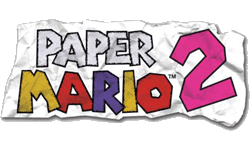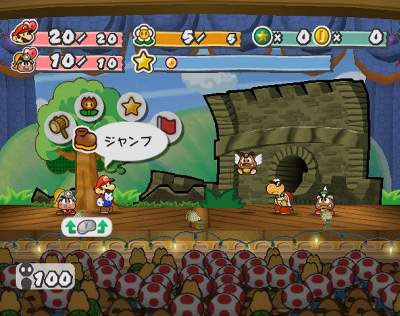|
|

|
BATTLE SYSTEM
|

|
INTERACTION
|

|
ORIGINALITY
|

|
STORY
|

|
MUSIC & SOUND
|

|
VISUALS
|

|
CHALLENGE
|
Easy
|
COMPLETION TIME
|
25-40 hours
|
|
OVERALL
4/5
|
Rating definitions
|
|
|
Mario goes on yet another adventure in Paper Mario: The Thousand-Year Door. This time around he is given a treasure map by Peach that will lead him to the stars needed to unlock the fabled Thousand-Year Door. Of course, there are plenty of quirky companions that will gladly assist in his quest too. Paper Mario 2 fixes almost all of the problems the original had, and unlike the original, it doesn't rely on Mario-related nostalgia to be fun and would be good whether or not it actually had Mario in it.
The largest improvement over the original is the battle system, which isn't painfully over-simplified like it was in the original. Timed hits allow the player to do more damage to enemies or take less damage from attacks if the right buttons are pushed at the right time. The badge system allows Mario to customize himself and his allies. It's even possible to swap Mario's allies as needed in battle. Some of these returning features have been slightly improved. For example, a new special timed defense has been added that allows Mario to take zero damage and even counter-attack if the player executes the command with perfect timing. It's more risky, but far more powerful. There are also many more badges to choose from, which means there are more possible strategies. These minor changes and additions are nice, but the two most notable elements are the fact that Mario's allies now possess HP too and the addition of a stage and audience. Since Mario's allies have HP now, they are far more useful in battle than they were earlier. Players can even put them in the front row so they can protect Mario if needed, adding another level of strategy. The audience becomes available fairly early in the game, grows in size periodically as Mario gains levels, and has a surprisingly large effect on the outcome of the battle. They can throw good or bad items at Mario and friends, cheer the good guys on to recover star power, or actually run onto the stage to directly assist either side just to name a few things they can do. If a boss is particularly cruel, they can even eat or drain some of the members of the audience to recover HP. In addition to simply fighting enemies, it is very important to keep the audience pleased by not missing timed hits and attempting to perform stylish moves to keep battles exciting. Since the audience can bestow large amounts of support or cause significant amounts of damage, it pays to keep an eye on them whenever possible. Should they turn on Mario, it's even possible to hit them before they can attack should the player hit the correct button in time.
 This is new
This is new
|
|
Timing is everything. Excellent timing will make the game very easy, as Mario will be able to dish out tons of bonus damage, recover star points quickly, and reduce the amount of damage he and his friends takes dramatically. On the other hand, failing timed hits will cause most of the audience too boo Mario, leave, or even attack him. This is, of course, in addition to the decreased attack and defensive power that failing timed hits will result in. Luckily, timed hits are usually quite easy to use. There's even a special badge that will teach players timing should they require assistance. This, in addition to ridiculously powerful items, make the game quite easy. There's a bonus dungeon for those seeking a challenge, but it isn't very difficult either.
As it relies heavily on timed hits, it's a good thing the game has a very good interface. Play control is excellent, both in battle and while exploring the world. Mario has a large number of new tricks, such as rolling into a paper tube and folding himself into a paper airplane, but all of his transformations are easy to control. In addition to the excellent play control one would expect from a Mario game, the game also boasts well organized menus and essentially flawless localization. The entire game is put together very well.
The largest original additions to series are Mario's new abilities, the stage, and the audience. Sadly, it still borrows heavily from the original and some parts feel like a rehash at times. Even the basic concept for the story comes right out of the original: Mario goes on an adventure to collect stars. Of course, it's a sequel, so it can't be docked much for this, and the additions to gameplay far outweigh the feeling of playing a rerun most of the time. Just enough has been changed, especially to the battle system, to merit a high score in originality.
 Battles are far more complex now
Battles are far more complex now
|
|
The basic story concept may be similar to the one found in other Mario RPGs, but this is the most developed story since the original. There is a large cast of characters and players get to see the story unfold from the points of view of several major characters including Mario, Peach, and Bowser. The story is humorous, light-hearted, and enjoyable, but it just can't compete with most of the other RPGs coming out these days. It also features a large amount of fetch quests, and the story often suffers from poor pacing as a result.
Fetch quests also add quite a bit of filler to boost the play time. Combined with the longer, more developed story, this makes Paper Mario 2 the longest game in the series yet; taking all of this into account, the game can take upwards of twenty-five hours to complete. There are plenty of rare power-ups and badges that can be found by backtracking or accepting the dozens of Trouble quests that can be found. There's even a hundred floor bonus dungeon to keep players busy. Mario's level cap is no longer thirty either, allowing players to build him much longer than in previous titles. All these extras can tack on an additional fifteen plus hours.
Despite being much longer than the first Paper Mario, the music becomes far less repetitive. There are plenty of good Mario music remixes to go around, and each major boss receives its own battle theme. Sadly, the rest of the tracks are average and tend to blend into the background. While that means they don't become repetitive, it also means that most of the music tends to be fairly unmemorable. Overall, the music is slightly above average but far from stellar. The sound effects are good, but they're pretty much just the same Mario sound effects that have been around for a decade or two.
Unlike the music, the visuals really stand out. At first glance, it may look almost exactly the same as the original, and many sprites seem to have been taken directly out of it and reused. Aside from that, the resolution is better, and literally hundreds of sprites can fill the screen and generally act independently from each other without slowing the game down at all. The paper style and effects also fit the game itself extremely well. The style is unique to the series and looks good since every character sprite has several frames of animation and is quite detailed. There is some palette-swapping, but most of it occurs in the bonus dungeon, so it's not much of an issue.
The massive improvements to the battle system and small improvements to gameplay and story bring Paper Mario 2 well above and beyond the level of its predecessor. It's a much longer and fuller adventure that would be fun if Mario was in it or not. Of course, Mario is in it, which is a big bonus for Mario fans and sure to trigger some nostalgia. Either way, the game as a whole is quite enjoyable and certainly worth a look.
Review Archives
|









